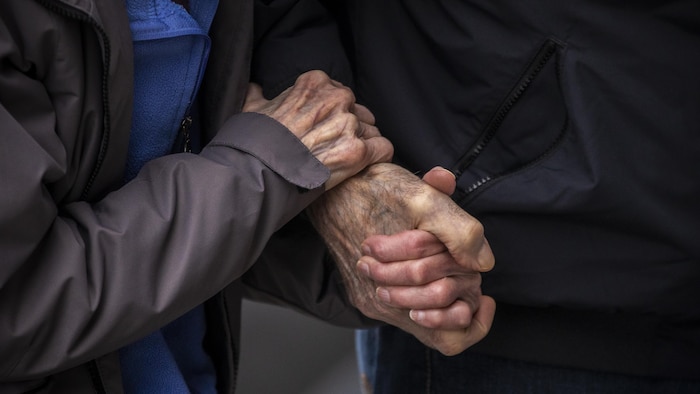Open in full screen mode More than 500,000 Canadians suffer from a neurocognitive disorder such as Alzheimer's disease. The Canadian Press The number of people living with neurocognitive disorders could jump 145% in Quebec by 2050, warns a new report from the Alzheimer Society of Canada, the conclusions of which were shared with The Canadian Press before their unveiling on Monday. This means that more than 360,000 people will have developed a neurocognitive disorder in the province by 2050, according to the report. Across Canada, an increase of 187% is expected over the same horizon, for a total of more than 1.7 million people living with the disease. We now know what we are facing, said Sylvie Grenier, general director of the Quebec Federation of Alzheimer Societies. It has been announced for several years, but there, it is described, we have the figures. We must now work to ensure that we support these people, that we ensure that their quality of life is maintained. The number of people of African origin living with neurocognitive disorders in Quebec is expected to increase from 1,460 to 11,490 by 2050, a jump of 687%. The anticipated increase will be 683% for people of Asian origin and 271% for people of Indigenous origin. Loading ELSEWHERE ON NEWS: Ottawa sets 'temporary two-year cap' on international students Given changing immigration trends, the ethnic profile of the country's elderly is changing, we can read in the document. This changing population profile is directly reflected in the ethnic backgrounds of those at risk of developing a neurocognitive disorder over the next 30 years. Women are twice as likely as men to suffer from neurocognitive disorders. In 2020, approximately two-thirds of people living with a neurocognitive disorder in Canada were women. And if current trends continue, by 2028, more than 100,000 women will be diagnosed with a neurocognitive disorder each year in Canada. Just over 91,500 people living with neurocognitive disorders in 2020 in Quebec were women; we could identify more than 225,000 by 2050, specifies the study entitledThe many facets of neurocognitive disorders in Canada. Now that we have this before us, we must act, said Sylvie Grenier. Although the report highlights the challenges facing Quebec and Canada in general, it also sheds instructive light on the situation prevailing within different sub-populations, whether people of indigenous, African or Asian origin. As is the case for the entire population, the aging of the population is accompanied by an increase in the risks of neurocognitive disorders in Indigenous communities, the document specifies.< /p> The study also highlights that colonization is a root cause associated with the risk of neurocognitive disorders and other health problems in indigenous populations. The legacy of colonization, she specifies, maintains in particular a socio-economic disadvantage which limits healthy choices (diet, physical activity, taking medications, etc.), increases stress levels and reduces the ability to take self-care and change to adopt healthy behaviors. The socio-economic context, continue the authors of the study, can have a significant impact on modifiable risk factors for neurocognitive disorders, such as diabetes, low educational level, head injuries, cardiovascular disease, alcohol consumption, childhood trauma, mid-life hypertension, obesity, physical inactivity and smoking. Income, employment, food security, housing and social exclusion are also in question. Due to the many impacts of colonialism, Indigenous populations in Canada are at increased risk of neurocognitive disorders associated with social determinants of health – the conditions in which people are born, grow, live, work and age – and upon which individuals exercise little control, we can read in the document. Other passages in the report resonate particularly in the Quebec context, where the relationships of members of the Indigenous community with the province's health system have often made headlines in recent years, usually for the wrong reasons. /p> The document warns that Indigenous peoples in Canada face a range of obstacles preventing them from accessing good care and , by extension, to good care for neurocognitive disorders. Poverty, cultural and linguistic differences, racism and lack of cultural safety in health care, distrust of health care providers, stigma associated with neurocognitive disorders, and the distance that separates communities of health centers are all factors that prevent indigenous populations from having access to the care they need, specifies the study. Racism experienced over several years is a form of psychosocial stress which causes structural changes in the physiology of the brain and accelerates its aging and the decline of memory, recall the authors of the study. Ontario is the Canadian province where the number of Indigenous people living with a neurocognitive disorder will increase the most by 2050; Quebec comes in second place. However, there is little data regarding the impact of neurocognitive disorders on indigenous populations. A few studies carried out over the years, particularly in Alberta, have shown higher rates of neurocognitive disorders among Aboriginal populations, and a more rapid increase in these rates. Sylvie Grenier, who heads the Quebec Federation of Alzheimer Societies, admits that links must be forged. We are not involved in the [indigenous] communities, they do not come to us, and yet we know that these people are also affected, she said. So, I have already been working for some time to create links with these communities, to ensure that we will work with them. We want to be able to create links and work to support them in their culture. We won't do for them, but we want to do with them. The goal, she added, is to ensure that no one will walk alone. We must therefore understand how we can reach as many people as possible, to be able to inform, to equip communities to take care of their elders, and then also to ensure that we maintain their quality of life, that there is a lesser impact. We will make sure to work with stakeholders in their communities to ensure that they are able to support their people, said Ms. Grenier. Even more so, she continues, since we now know that healthy lifestyle habits – such as physical activity, diet, absence of smoking and others – can delay the appearance of the first symptoms by around ten years. It is therefore important that the entire population, indigenous or not, have access to the resources and information necessary for this purpose. 40 years ago, adds Ms. Grenier, a diagnosis of cancer was inevitable and the chances of recovery were slim. This is a bit like the situation in which Alzheimer's disease finds itself today: cure is not possible, but that does not mean that patients are condemned to passivity. It doesn't help not to go for a consultation because we prefer not to know, he said. she says. The sooner we have a diagnosis, the sooner we can intervene in the course of the disease and work with people, supporting them to ensure that we maintain their quality of life. Life does not end with diagnosis. We still have power over our lives at this time.
Ottawa establishes “temporary two-year cap” targeting foreign students
Neurocognitive disorders: 145% increase in cases in Quebec by 2050

